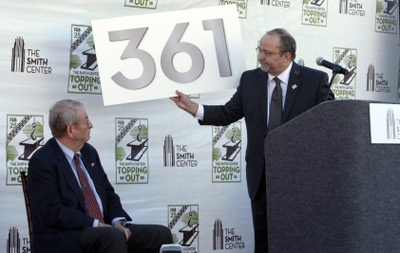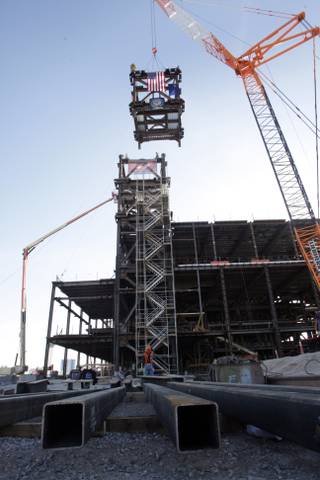Martin muses about Willie Nelson and a March 2012 opening for Smith Center
Thursday, April 15, 2010 | 1:56 a.m.
Audio Clip
- Smith Center exec Myron Martin

Myron Martin, right, Smith Center president and CEO, announces the street address of the center to Fred Smith, chairman of the Donald W. Reynolds Foundation, during a topping-off ceremony for the Smith Center for the Performing Arts in downtown Las Vegas Thursday, February 25, 2010. The number commemorates the Smith's marriage anniversary (March 1961). The center is named after Fred Smith and his wife Mary.

Fred Smith, center, chairman of the Donald W. Reynolds Foundation, receives applause during a topping-off ceremony for the Smith Center for the Performing Arts in downtown Las Vegas Thursday, February 25, 2010. On stage with Smith are Myron Martin, left, Smith Center president and CEO, and Don Snyder, chairman of the Smith Center. The center is named after Fred Smith and his wife Mary.
You might expect, say, a touring production such as "Wicked" to one day visit the Smith Center for the Performing Arts.
Nor would it be a surprise to see "Mary Poppins," umbrella aloft, floating daintily into the new entertainment center in Symphony Park.
But Willie Nelson? Mr. "Whiskey River," and inhabitant of the most notoriously smoke-filled tour buses in entertainment history?
It shall be so, says Smith Center for the Performing Arts executive Myron Martin.
Martin appeared on the most recent episode of "Our Metropolis" on KUNV 91.5-FM (this is the weekly issues and affairs program I host at 6 p.m. Tuesdays). While explaining how the 2,050-seat Reynolds Hall, with its vast stage and orchestra pit, would serve to showcase artists in ways not possible in most hotel-casino showrooms, Martin unexpectedly inserted Nelson's name into the conversation.
But first, Martin mentioned Fred Smith, and he and Nelson are linked, in a way.
"Fred Smith — Fred W. Smith, chairman of the Donald W. Reynolds Foundation, whose name is on our building, that's where the Smith Center comes from — is a huge Willie Nelson fan," Martin said. "Some people say, '(This is) a performing arts center. What are you going to bring Willie Nelson for? Isn't that only for the symphony, opera and ballet crowd?' No. There's something for everybody at the Smith Center. We're going to do something special for Mr. Smith, too.
"We're going to bring Willie here, and you're going to see him in a way that you might not see him in a hotel-casino. We have not booked that one yet, but we hope to have him here in the first year."
While he was not ready to reveal any specific artists lined up to appear on the Smith Center's first-year calendar of events, Martin did, for the first time, specify an opening month: March 2012. Previously, officials said only that the $475 million project would open in the spring of 2012.
With a regal bell tower as its signature external architectural feature, Smith Center will open with the big hall, a 300-seat cabaret theater and a 200-seat studio theater as its indoor show venues. Martin also pointed out the two-acre outdoor amphitheater green space at the front of the complex, which can stage free and ticketed shows for "a few thousand" fans.
"We don't want to duplicate what (Clark County Government Center) is already doing (with its free jazz performances), nor do we want to compete with them in that way," Martin said. "But we have some ideas that will fit in very nicely with what they are doing, and what the city of Las Vegas is doing, too, so stay tuned."
During the broadcast, Martin also addressed concerns that fans of (and musicians in) the Las Vegas Philharmonic have about renting what seems a more expensive facility than its current home, UNLV's Ham Hall. He also said it was unlikely community theater organizations would uproot from their communities to perform at the smaller Smith Center venues.
Additional highlights from the interview:
When asked which Broadway shows would be booked the Smith Center if it were open today: "(Laughs) That sounds like good way of asking what's going to open our season without actually asking. Let's not talk about our opening season, or about the Smith Center in particular at the moment, but there are a number of big productions. For instance: One of the most important touring Broadway shows on the planet is a show called 'Wicked.' This is the prequel to the 'Wizard of Oz.' It's huge on Broadway, it's giant on the road, and it's never been to Las Vegas.
"'Billy Elliot,' the Elton John musical, is probably not a fit for a hotel-casino. 'Mary Poppins,' the great Disney Broadway hit, is probably not going to find its way to Las Vegas hotel-casino, and it's a spectacular production. You start looking at what has and has not worked in Las Vegas in terms of Broadway productions. Remember, I was the guy who the New York Times quoted as saying that Las Vegas was going to become Broadway West. Well, OK, I'm wrong every once in a while."
Looking back on the short-lived Las Vegas production of "Hairspray," which Martin co-produced, and the need for a non-casino performance hall for Broadway-caliber shows: "("Hairspray") was a stunning production that we were all very proud of, and what we were proudest of was, when we first opened, we had three or four weeks of a kind of a soft opening that was really geared toward locals. Every show was full, and after every show I would go out into the audience and I would see people that I know and I would see people who look familiar. I knew I had a hit for those of us who live here.
"But the reality was, we all had to get in our cars and drive and park at a hotel-casino, and bring our kids through the slot machines and all that. At the Smith Center, for two or three or four weeks, we're bringing the biggest Broadway shows into a non-gaming, truly world-class facility — that's what people who have been living here have been asking for."
Explaining what happened to the 650-seat theater that was detailed in early Smith Center plans, but has since been removed: Its primary role was to be the home of Nevada Ballet Theatre. They're currently doing most of their productions at the Judy Bayley Theater at UNLV at 500 and some-odd seats, 550. They wanted to move to the Smith Center, and they wanted to be a little bigger than they'd been in the past. So we planned accordingly and designed a theater that was going to be great for the ballet.
"As we got closer and closer to groundbreaking, the ballet said, "You know, that large hall looks great. If we're going to get to the next level artistically and in other ways, we really think we need to do our performances in the large hall, the 2,050-seater." All right, 2,000-2,050 seats is three times as many as 650 seats, so you're probably going to have to have to have a third as many performances. Once upon a time, the ballet's goal included giving the dancers as many performance opportunities as possible. The current thinking at the ballet — and I think they're right, by the way — is that, for them to get to the next level artistically, they need a real orchestra in the pit, not just recorded music. And they need to give their dancers the best experience possible. Therefore, fewer performances in a bigger hall with a live orchestra was their decision, and it was one we endorsed.
"But now that we don't have the ballet taking up most of the dates in the 650-seat theater, we decided to pull it out of our building program, which was the right thing to do. What they saw was a chance to go into a truly world class, state-of-the-art place. The good news for them is, if they do a performance and have 1,000 or 1,200 people in the audience, we'll block off the top balcony. Everyone will sit nicely in the other three levels. ... We just won't sell it, won't light it, you won't know it's there, in that case. That's part of the design that works really well."
On the remaining construction schedule: The topping out ceremony (in February) proved that we are finished with the steel and the construction continues — we're about nine and a half months into construction, now. We'll get the keys, so to speak, in December 2011. We'll have the next three months to tune the building, acoustically and in many other ways, so that when we open in March of 2012, the inside of the building will be as world-class as the architecture itself."





